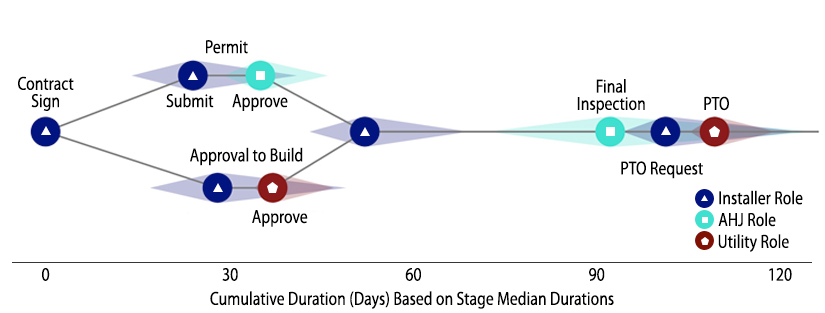
As the adoption of solar energy in the United States accelerates, one hurdle still slows the race toward clean energy: permitting. While advances in solar technology have made installations faster and more cost-effective, the permitting process often lags, delaying projects and frustrating stakeholders. Promised approval times frequently fall short of reality, but recent initiatives are working to bridge the gap.
What is Solar Permitting?
The solar permitting process ensures that installations comply with local building codes and safety standards. This involves submitting detailed project plans to Authorities Having Jurisdiction (AHJs), undergoing inspections, and securing interconnection agreements with utility companies. While meant to protect public safety and grid integrity, this process often stretches far beyond expected timelines.
According to the National Renewable Energy Laboratory (NREL), delays in permitting, inspection, and interconnection are a significant bottleneck in U.S. solar adoption. A study of over 200,000 projects found that while some jurisdictions aim for rapid approval, actual timelines often exceed initial promises by weeks or even months.
How Big is the Problem?
The delays impact residential and commercial projects differently. Some regions, particularly those with established solar markets, boast relatively smooth processes. Others face fragmented, inconsistent procedures that result in long wait times. These delays increase costs for installers, hinder customer satisfaction, and slow the renewable energy transition.
The data tells a stark story:
- Median processing times for permitting, inspections, and interconnection vary significantly by region, with some projects taking weeks longer than necessary.
- Extended delays often result in missed deadlines, additional labor costs, and frustrated customers.
Programs Leading the Charge
Several initiatives aim to address these challenges by standardizing and streamlining the solar permitting process:
1. SolarAPP+: Automating Approvals
The Solar Automated Permit Processing Plus (SolarAPP+) platform, developed by NREL, automates the permitting process for residential solar projects. By standardizing applications and enabling instant approvals for qualifying systems, SolarAPP+ reduces processing times from weeks to hours. This tool is a game-changer for jurisdictions that adopt it, slashing red tape and enabling faster installations. However, this is not a customer-facing tools, and frankly, there isn’t much you can do on your own, other than urge your community to adopt this process.
As of November 2024, SolarAPP+™ has been adopted by 181 communities across the United States, streamlining the permitting process for residential solar installations. This widespread adoption has led to the issuance of over 46,500 permits, approval of more than 302,350 kilowatts of solar capacity, and an estimated saving of 46,500 hours in review time.
Check here, if your community has already adopted SolarAPP+
Notable Adopters:
City of Stockton, California: Processed 1,662 permits, approving 14,658 kW, with an estimated 2,407 hours saved.
City of Tucson, Arizona: Issued 6,407 permits, approving 43,931 kW, and saving approximately 6,509 hours in review time.
City of Phoenix, Arizona: Processed 4,215 permits, approving 29,766 kW, with an estimated 4,215 hours saved.
Pima County, Arizona: Approved 4,294 permits, totaling 33,324 kW, and saving about 4,440 hours.
City of Simi Valley, California: Issued 1,384 permits, approving 13,176 kW, and saving approximately 1,961 hours.
2. SolarTRACE: Bringing Transparency
SolarTRACE is a comprehensive tool designed to shed light on permitting, inspection, and interconnection timelines across the country. It provides median cycle time data for different jurisdictions, helping identify bottlenecks and promoting best practices. This transparency empowers local governments and installers to work together to optimize processes.
3. SolSmart: Encouraging Excellence
Funded by the U.S. Department of Energy, the SolSmart program recognizes communities that reduce solar development barriers. By offering technical assistance and awarding designations, SolSmart incentivizes municipalities to adopt solar-friendly practices, including streamlined permitting.
Impact of Streamlined Permitting
The adoption of these tools and programs is making a measurable difference:
- Jurisdictions using SolarAPP+ report approval times dropping from as long as 20 business days to instant same-day processing for eligible projects.
- Communities participating in SolSmart often report improved customer satisfaction and higher solar adoption rates.
Streamlined permitting doesn’t just benefit solar installers—it reduces costs for homeowners and accelerates the nation’s shift toward renewable energy.
Visualizing the Process
Below is a simplified flowchart that outlines the key steps in solar permitting and how tools like SolarAPP+ and SolarTRACE can transform the timeline:

The Road Ahead
While progress is being made, the U.S. solar permitting process still has room for improvement. Scaling programs like SolarAPP+ and expanding participation in initiatives like SolSmart can align actual processing times with expectations. By reducing red tape, the nation can move closer to a future powered by clean, renewable energy.













